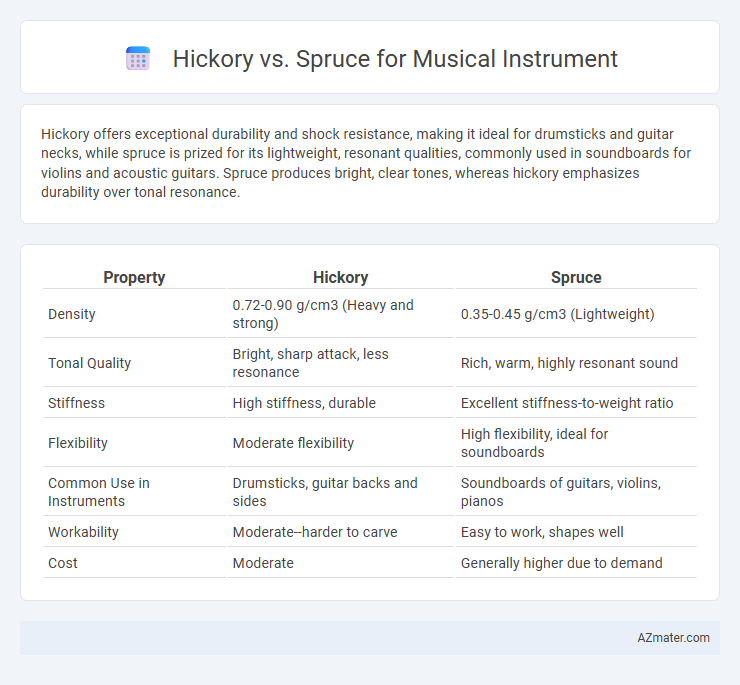Hickory offers exceptional durability and shock resistance, making it ideal for drumsticks and guitar necks, while spruce is prized for its lightweight, resonant qualities, commonly used in soundboards for violins and acoustic guitars. Spruce produces bright, clear tones, whereas hickory emphasizes durability over tonal resonance.
Table of Comparison
| Property | Hickory | Spruce |
|---|---|---|
| Density | 0.72-0.90 g/cm3 (Heavy and strong) | 0.35-0.45 g/cm3 (Lightweight) |
| Tonal Quality | Bright, sharp attack, less resonance | Rich, warm, highly resonant sound |
| Stiffness | High stiffness, durable | Excellent stiffness-to-weight ratio |
| Flexibility | Moderate flexibility | High flexibility, ideal for soundboards |
| Common Use in Instruments | Drumsticks, guitar backs and sides | Soundboards of guitars, violins, pianos |
| Workability | Moderate--harder to carve | Easy to work, shapes well |
| Cost | Moderate | Generally higher due to demand |
Introduction to Hickory and Spruce in Musical Instruments
Hickory and spruce are commonly used tonewoods in musical instrument construction, each offering unique acoustic properties. Hickory provides exceptional strength and durability, making it ideal for drumsticks and guitar necks where resilience is crucial. Spruce is prized for its lightweight and resonant qualities, often chosen as the primary soundboard material in guitars, violins, and pianos to deliver bright, clear tones with excellent projection.
Physical Properties: Hickory vs Spruce
Hickory wood boasts exceptional density and hardness, providing durability and strong resistance to impact, making it suitable for instruments requiring robust build quality. Spruce, known for its lightweight and high stiffness-to-weight ratio, delivers superior resonance and bright tonal clarity favored in soundboards and acoustic instrument tops. The contrasting physical properties of hickory's heavy, tough fibers versus spruce's flexible, lightweight grain significantly influence sound projection and instrument weight.
Acoustic Characteristics of Hickory
Hickory wood in musical instruments delivers a bright, clear tone with strong midrange presence, providing excellent projection and a balanced sound suitable for stringed instruments. Its dense grain structure enhances sustain and dynamic response, producing a crisp attack while maintaining warmth in the lower frequencies. Compared to spruce, hickory offers increased durability and a slightly more pronounced percussive quality, ideal for players seeking clarity and robustness in their acoustic performance.
Acoustic Qualities of Spruce
Spruce is highly valued for its outstanding acoustic qualities, offering a bright, clear tone with excellent resonance and sustain, making it a preferred top wood for acoustic guitars and violins. Its lightweight yet strong grain structure allows for superior sound projection and dynamic range compared to hickory, which tends to produce a denser, harsher tone. Spruce's responsiveness under varying playing styles enhances its popularity in crafting premium musical instruments.
Durability and Longevity Comparison
Hickory offers exceptional durability and resistance to wear, making it ideal for musical instruments subjected to heavy use and impact. Spruce, while less dense, provides reliable longevity with its natural flexibility and excellent tonal qualities but is more prone to dents and scratches over time. Instruments crafted from hickory often endure extended performance lifespans, whereas spruce requires careful handling to maintain its structural integrity.
Aesthetic Differences in Finished Instruments
Hickory wood in musical instruments offers a rich, dark grain with a rugged, textured finish that enhances a vintage or rustic aesthetic, often favored for its bold visual impact. Spruce features a lighter, more uniform color with a fine, straight grain that provides a sleek, polished look commonly associated with classical and modern instruments. These aesthetic differences significantly influence the instrument's visual appeal, complementing the tonal qualities preferred by musicians and instrument makers.
Suitability for Different Types of Musical Instruments
Hickory wood, known for its density and strength, is ideal for percussion instruments like drumsticks and drum shells, offering durability and excellent shock absorption. Spruce, prized for its light weight and superior resonance, is the preferred choice for soundboards in stringed instruments such as guitars, violins, and pianos, delivering clear, vibrant tones. The contrast in acoustic properties between hickory and spruce makes them suitable for distinct musical instrument families, with hickory favoring impact resistance and spruce enhancing tonal clarity.
Tone and Resonance: Hickory vs Spruce
Spruce is renowned for its bright, clear tone and excellent resonance, making it a top choice for soundboards in guitars and violins due to its lightweight yet strong cellular structure that amplifies vibrations effectively. Hickory, being denser and heavier, produces a more robust and punchy sound with less resonance, often favored for instruments requiring durability and a percussive tonal quality, such as drumsticks and some electric guitar necks. The tonal brightness and sustain of spruce contrast sharply with hickory's warmer, more resonant-focused sound profile, influencing the instrument's overall acoustic character.
Cost and Availability of Each Wood
Hickory is generally more affordable and readily available due to its widespread growth in North America, making it a cost-effective choice for musical instrument construction. Spruce, particularly Sitka and Engelmann varieties, tends to be more expensive and less abundant, valued for its superior tonal qualities and preferred in high-end instruments like guitars and violins. Availability of spruce can fluctuate due to environmental factors and harvesting restrictions, often driving up costs compared to the more plentiful hickory.
Choosing the Right Wood for Your Musical Needs
Hickory offers exceptional strength and durability, making it ideal for drumsticks and guitar necks where impact resistance is crucial, while spruce is prized for its lightweight and resonant qualities, commonly used in soundboards for acoustic guitars and violins to enhance tonal clarity. Choosing between hickory and spruce depends on balancing durability with sound quality, as hickory provides robustness and ruggedness, whereas spruce delivers superior acoustic projection and responsiveness. Understanding your instrument's function and desired tonal characteristics ensures the right wood selection, optimizing performance and longevity.

Infographic: Hickory vs Spruce for Musical Instrument
 azmater.com
azmater.com